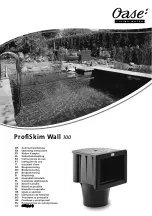
Page 4
Pentair Water Commercial Pool and Spa
All boilers must be installed on a non-combustible
floor. Under no circumstances can boilers be installed
on carpeting. The National Fuel Code allows a boiler
to be placed on other than a non combustible surface
when such an installation complies with the local
codes. This code specifies the surface under the boiler
be protected with hollow masonry no less than 4" thick,
covered with sheet metal at least 20 gage in thickness.
Such masonry must be laid with ends unsealed, and
joints matched in such a way as to provide a free
circulation of air from side to side through the masonry
(see Figure 2).
cause accelerated deterioration of controls and
electrical components.
3.
Exhaust Fans or Vents: Any equipment which
exhausts air from the boiler room can deplete the
combustion air supply or reverse the natural draft
action of the venting system. This could cause
flue products to accumulate in the room.
Additional air must be supplied to compensate
for such exhaust. The information in Table 2 is
not applicable in installations where exhaust
fans or blowers of any type are used. Such
installations must be designed by qualified
engineers.
Figure 2. Non-Combustible Base.
2B. Installation of Indoor Boilers
2B-1. Combustion Air Supply
1.
The boiler location must provide sufficient air
supply for proper combustion, and ventilation of
the surrounding area as outlined in the latest
edition of ANSI standard Z223.1 or, in Canada
CAN1-B149, and any local codes that may be
applicable. Inadequate combustion air supply
may result in incomplete combustion and
consequent sooting of the heat exchange and
unsafe operation of the boiler.
2.
In general, (in the U.S.), these requirements
specify that equipment rooms which represent
confined spaces should be provided with two
permanent air supply openings communicating
directly through the wall to outside air; one
within 12 inches of the ceiling, the other within
12 inches of the floor. Each opening should have
a minimum free area of one square inch per
4,000 BTUH input of the total input rating of all
appliances in the enclosed area. These
requirements differ in Canada. Consult the
National Standard of Canada CAN1-B149 for
details. See Table 2 for recommended air supply
for U.S. models. An improperly ventilated
equipment room can get excessively hot and
Clearance
Indoor
Outdoor
From
(Inches)
(Inches)
Top
24
—
Water Conn. Side
24
24
Opposite Side
24
24
Front
48
48
Rear
24
24
Vent
6
—
Table 1. Minimum Boiler Clearance
From Combustible Surfaces
Indoor
Each Opening*
Size
(Square Inches)
2000
500
2450
613
3050
763
3500
875
4050
1013
4500
1125
5000
1250
Net Free Area in Square Inches*
*Area indicated is for one of two openings: one at floor level
and one at the ceiling, so the total net free area would be
double the figures indicated. For all other conditions, refer to
latest edition of ANSI A223.1.
NOTE: Check with louver manufacturers for Net Free Area of
louvers. Correct for screen resistance to the Net Free Area if
a screen is installed. Check all local codes applicable to
combustion air.
Table 2. Minimum Recommended Air
Supply to Equipment Room.
4.
If a blower or fan is used to supply air to the
equipment room, the installer should make sure it
does not create drafts which could cause
nuisance shut-downs of the pilot. If a blower is
necessary to provide adequate combustion air to
the boiler, a suitable switch or equivalent must
be wired into the boiler control circuit to prevent
the boiler from firing unless the blower is
operating.
5.
The boiler must be completely isolated and
protected from any source of corrosive chemical
fumes such as emitted by trichlorethylene,
perchlorethylene, chlorine, etc.
Blocks must provide solid base and be braced so they cannot
slip out of place. Air openings in blocks must be arranged to
provide unobstructed opening through entire width or length of
base.





































